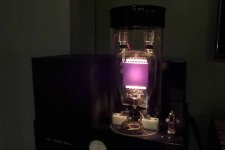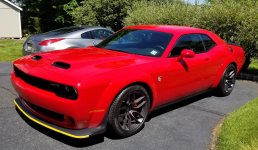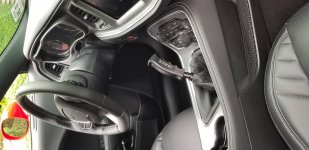Hello,
I’m trying to understand the point of an 845, 211, 805, etc. amplifier. Let me explain:
From what I understand, all things being equal, and assuming competent circuit design, parts quality, etc. the more gain stages an amplifier has, the less likely it is to be linear. And, from what I understand, generally speaking, the more transformers involved in a circuit, the more it will suffer from transformer-based distortion.
I’ve never heard such an amp, mind you, so maybe the proof is in the pudding. But as a general observation, all of the amps that I’ve seen that use these tubes in their power section are all preceded by something like an input tube such as a 6922 or 12ax7, followed by a 300b or 6L6 section (described as the driver section), then followed by an 845, etc. Or, it omits the input section and requires a separate preamp. In any event, all of such amps seem to have a veritable village of transformers stacked around these tubes, or because of weight and space limitations, stacked in a separate case.
Are these amplifiers really more linear than say, a El34 ultra linear amp running in class A designed with, again, a quality circuit, parts, etc.? Is there something super special that I’m missing in an 845 SET amp (line magnetic, for example) that can’t be achieved in a 6p15 SET (Decware zen Torii, for example) plus a quality subwoofer?
I’m trying to understand the point of an 845, 211, 805, etc. amplifier. Let me explain:
From what I understand, all things being equal, and assuming competent circuit design, parts quality, etc. the more gain stages an amplifier has, the less likely it is to be linear. And, from what I understand, generally speaking, the more transformers involved in a circuit, the more it will suffer from transformer-based distortion.
I’ve never heard such an amp, mind you, so maybe the proof is in the pudding. But as a general observation, all of the amps that I’ve seen that use these tubes in their power section are all preceded by something like an input tube such as a 6922 or 12ax7, followed by a 300b or 6L6 section (described as the driver section), then followed by an 845, etc. Or, it omits the input section and requires a separate preamp. In any event, all of such amps seem to have a veritable village of transformers stacked around these tubes, or because of weight and space limitations, stacked in a separate case.
Are these amplifiers really more linear than say, a El34 ultra linear amp running in class A designed with, again, a quality circuit, parts, etc.? Is there something super special that I’m missing in an 845 SET amp (line magnetic, for example) that can’t be achieved in a 6p15 SET (Decware zen Torii, for example) plus a quality subwoofer?
generally speaking, the more transformers involved in a circuit, the more it will suffer from transformer-based distortion.
This may hold some academic merit bit is completely irrelevant in real life. Good transformers have negligibly low harmonic distortion and subjectively sound more transparent than capacitors. At least to some listeners.
Not sure why would you compare any of the big transmission valves to an EL34, at the very least they offer a much higher power compared to a triode strapped EL34.
As for the linearity, some very highly regarded amps are far from linear. Perhaps we should not overstate its importance.
As with everything else it all boils down to implementation. It is very easy to end up with a poor sound amp full of transformers, chokes and transmission valves.
Its beyond me why they use these expensive 845, 211, 805 tubes, when a GM70 or GK71 price is only $17
''GSTube.com''. Tubes, sockets etc. Search result for <u>gm70</u>
They use 12AX7 why is a ready available tube in China and have lots of gain 100x
''GSTube.com''. Tubes, sockets etc. Search result for <u>gm70</u>
They use 12AX7 why is a ready available tube in China and have lots of gain 100x
Last edited:
The "super special" that can't be acheived with a Decware or similar amplifier should be quite obvious- it isn't a big, huge, hot "statement" of an amplifier the same way the impractically heavy and large amps are. For some folks they have a biting desire to simply make something that way, so they do.
While the car they drive is different than yours, and the road they drive is different, they still aim to take the same journey to audio enjoyment. It's fun, it's ridiculous, and it's expensive. It's all valid to an extent.
While the car they drive is different than yours, and the road they drive is different, they still aim to take the same journey to audio enjoyment. It's fun, it's ridiculous, and it's expensive. It's all valid to an extent.
Are these amplifiers really more linear than say, a El34 ultra linear amp running in class A designed with, again, a quality circuit, parts, etc.?
Quite on the contrary, winding an output transformer for such tubes is a nightmare if you aim at full range operation and just want +-3dB from say 25Hz to 40kHz.
But then again, for some people there might be more aspects to an amplifier than linearity.
This may be both anecdotal and mathematically possible to formalize, but in my experience, one shouldn't ask each voltage gain stage to maximize its gain. Doing so seems to 'accentuate the triode/pentode distortion' of the stage.
For instance … whether one uses 6SN7s — hugely reputed to be marvelously linear — or 12AX7's or any of its socket substitutes of equally legendary quality, since the incoming signal to a main amp is relatively low (typically 700 mVRMS, allowing for ±3000 mVPK) … having the first stage being “only” a 10× to 15× gain merit is a good balance between minimizing noise and stage distortion at the same time.
Now the signal is (say) 15 × 700 mVRMS = 10 VRMS.
Great! As KodaBMX has posted in other fora, the next stage is optimally the symmetric signal inverter (supposing feed to a push-pull output section).
Higher current valves such as the 6SN7 seem to do well, tho' there's not a thing in the world wrong with low power pentodes. Not-exquisitely-matched anode and cathode resistors … plus a trimmer to dial in symmetry … then gives a nice pair of complementary VRMS ≈ 10 V signals.
THEN … each phase is voltage-amplified again.
Not much, maybe only 3× or 4× at the next stage. A single 6SN7 or other dual triode (or dual pentode) manages this well without a capacitor bypassed cathode resistor. Now with VRMS at about 35 V, there is a good strong drive for some powerful output valves in PP configuration.
Just saying,
GoatGuy ✓
For instance … whether one uses 6SN7s — hugely reputed to be marvelously linear — or 12AX7's or any of its socket substitutes of equally legendary quality, since the incoming signal to a main amp is relatively low (typically 700 mVRMS, allowing for ±3000 mVPK) … having the first stage being “only” a 10× to 15× gain merit is a good balance between minimizing noise and stage distortion at the same time.
Now the signal is (say) 15 × 700 mVRMS = 10 VRMS.
Great! As KodaBMX has posted in other fora, the next stage is optimally the symmetric signal inverter (supposing feed to a push-pull output section).
Higher current valves such as the 6SN7 seem to do well, tho' there's not a thing in the world wrong with low power pentodes. Not-exquisitely-matched anode and cathode resistors … plus a trimmer to dial in symmetry … then gives a nice pair of complementary VRMS ≈ 10 V signals.
THEN … each phase is voltage-amplified again.
Not much, maybe only 3× or 4× at the next stage. A single 6SN7 or other dual triode (or dual pentode) manages this well without a capacitor bypassed cathode resistor. Now with VRMS at about 35 V, there is a good strong drive for some powerful output valves in PP configuration.
Just saying,
GoatGuy ✓
So, what I’m gathering so far is that I’m not missing anything other than perhaps a physical behemoth of an amp when compared to, say, your typical PP integrated El34-sized fare, all other things being equal.
I own both a Decware SE84 CKC (SET EL84, 2 watts) and Torii Junior (PP EL34 UL, 20 watts) and, imho, the Jr. outclasses the CKC in terms of soundstage depth (which apparently is an artifact of negative phase 2nd harmonic—here somewhat adjustable, apparently, via the VR tubes in the circuit—at least that’s what my ears tell me) and power.
I’m thoroughly chuffed with the sound of the Jr. running it into Klipsch RB 81 mkii speakers (97 dB efficient supposedly), but, not having heard an 845, etc., was just making sure that there wasn’t another nearly universally accepted higher level of enjoyment that I’m missing out on comparatively speaking, by moving to transmission-line-tube level amps.
I own both a Decware SE84 CKC (SET EL84, 2 watts) and Torii Junior (PP EL34 UL, 20 watts) and, imho, the Jr. outclasses the CKC in terms of soundstage depth (which apparently is an artifact of negative phase 2nd harmonic—here somewhat adjustable, apparently, via the VR tubes in the circuit—at least that’s what my ears tell me) and power.
I’m thoroughly chuffed with the sound of the Jr. running it into Klipsch RB 81 mkii speakers (97 dB efficient supposedly), but, not having heard an 845, etc., was just making sure that there wasn’t another nearly universally accepted higher level of enjoyment that I’m missing out on comparatively speaking, by moving to transmission-line-tube level amps.
I confirm the GM70 tube price is $17.50 each graphite plate version its a impressive tube.I think the price of $17 is for sockets not the tubes
The socket for this tube has no price why its out of stock.
I had bough various GM70 and 6C33 tubes from Andrey.
Last edited:
You've got to wade through a lot of ad-copy type of speak, even among the DIY side of tube and "audiophile" hobbyists. Everyone has a special idea that they swear by, and there are a lot of "spiritual" reasons behind design decisions, regardless of whether or not they're good engineering or financially sound.
If you like what you have, cool. Don't let it stop you from building/buying different amplifiers or speakers. Try different stuff, even wildly different. Step outside of your comfort zone and build something crazy, everyone should build a boat-anchor of an amplifier at least once.
If you like what you have, cool. Don't let it stop you from building/buying different amplifiers or speakers. Try different stuff, even wildly different. Step outside of your comfort zone and build something crazy, everyone should build a boat-anchor of an amplifier at least once.
I listen to 200WPC 833C amps and drive a 717HP Challenger Hellcat with a manual transmission. I guess I like impracticality and excess. Sue me as I luxuriate in both, while I'm still allowed to.
Attachments
the more transformers involved in a circuit, the more it will suffer
Good transformers can be made, they just cost a lot. That's why my 845 SE amp only has one transformer in the signal path....the OPT.
I listen to 200WPC 833C amps and drive a 717HP Challenger Hellcat with a manual transmission. I guess I like impracticality and excess.
I remember the initial opening of your build thread......
"That's not an amp, that's a Midlife Crisis!" -My reply, "Hey, it's cheaper than a Corvette..."
I started down the same road, on a much lower budget. Budget for both evaporated when my 41 year engineering career ended. Let's just say that neither the 833A or the Challenger got completed, though both got to show off their abilities.
The 845 SE amp did too good a job heating my room. Not much fun when you are in a small room in South Florida, so it saw limited use.
It will be welcome here during the winter when the white stuff is taller than a 211 tube, therefore it will be rebuilt with some serious revisions.
No changes are needed in the sound department, but having exposed 1100 volt wiring is not good when there are young grandkids running about......for now it sits far from a power outlet.
Attachments
-
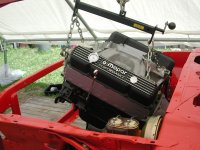 DSCN1258_x.jpg521.6 KB · Views: 296
DSCN1258_x.jpg521.6 KB · Views: 296 -
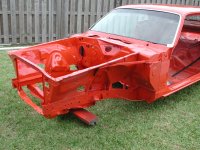 DSCN0281_x.jpg630.2 KB · Views: 244
DSCN0281_x.jpg630.2 KB · Views: 244 -
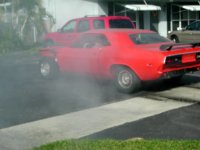 Challenger_3.jpg817 KB · Views: 272
Challenger_3.jpg817 KB · Views: 272 -
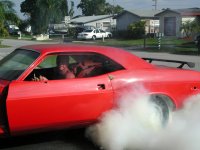 Challenger_2.jpg975.6 KB · Views: 352
Challenger_2.jpg975.6 KB · Views: 352 -
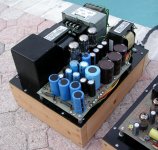 PowerSupply_a.jpg279.5 KB · Views: 347
PowerSupply_a.jpg279.5 KB · Views: 347 -
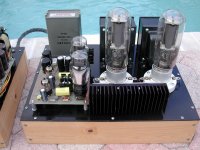 Amp_a.jpg302.5 KB · Views: 361
Amp_a.jpg302.5 KB · Views: 361 -
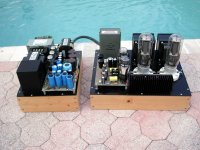 BothChassis_a.jpg338.5 KB · Views: 384
BothChassis_a.jpg338.5 KB · Views: 384 -
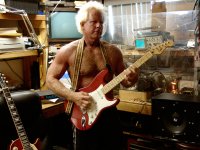 StratTest1.jpg752.9 KB · Views: 795
StratTest1.jpg752.9 KB · Views: 795 -
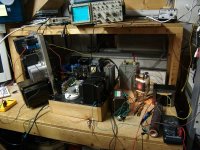 200Wattsa-2.jpg137.8 KB · Views: 862
200Wattsa-2.jpg137.8 KB · Views: 862 -
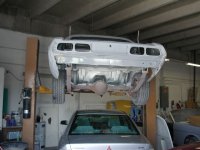 DSCN0189a.jpg67.6 KB · Views: 282
DSCN0189a.jpg67.6 KB · Views: 282
It's been years since I heard an 805 amp, and I'm not a big fan of the 211, but I can confidently say that the 845, if properly set up, has an authority and sense of realism that are difficult to duplicate with other output tubes. Rich, full-bodied voices, pianos and orchestras simply appear in the room. You don't need a ton of transformers, either. A triode-wired EL34 as driver, and a suitable small-signal input stage, all cap-coupled, will suffice. In SE, it has bass that you'll never get from a 300B. In PP, it can be simply glorious. I've heard a 100wpc PP 845 amp that had the ease and delicacy of an SE amp but none of the limitations, to say the least. And David Berning makes a PP 845 amp that stunned everyone who was at a demo he gave for a group of Maryland DIYers a couple of years ago.
It's not hype and it's not snake-oil. It's a glorious tube. But it's a pain to work with, the iron is perforce heavy, the voltages are truly deadly and they can heat a small barn. But there's nothing like it in my experience. I've built three SE 845 amps for friends, and 15 years later they are all still working and still being enjoyed. Unfortunately I forgot to keep one for myself. I don't have the energy to do it again, but I still have the iron (including the Magnequest FS-100's) and figure that *someday* I'll manage to build it again.
It's not hype and it's not snake-oil. It's a glorious tube. But it's a pain to work with, the iron is perforce heavy, the voltages are truly deadly and they can heat a small barn. But there's nothing like it in my experience. I've built three SE 845 amps for friends, and 15 years later they are all still working and still being enjoyed. Unfortunately I forgot to keep one for myself. I don't have the energy to do it again, but I still have the iron (including the Magnequest FS-100's) and figure that *someday* I'll manage to build it again.
Last edited:
Good transformers can be made, they just cost a lot. That's why my 845 SE amp only has one transformer in the signal path....the OPT.
I remember the initial opening of your build thread......
"That's not an amp, that's a Midlife Crisis!" -My reply, "Hey, it's cheaper than a Corvette..."
Yeah, I guess I ended up with the amps AND the car eventually. The Hellcat is a boat load of fun, for sure! That old school Challenger looks sweet; always loved them.
Last edited:
Who told you that? Have a look at McIntosh's MC-3550/MI-350 amplifiers: Seven cascaded active stages, including the finals, and super low THD and IMD of 0.15% each @ full nominal output power of 350 watts! All this throughout the frequency range of 20 to 20.000 Hz! And no transformers besides the PT's (there are two of them) and the OT....the more gain stages an amplifier has, the less likely it is to be linear...
I doubt that this amplifier's performance will be met by any of those old-fashioned, transformer coupled DHT designs.
Best regards!
People buy/build what they want to buy/build. They then seek to justify their choice by making technical claims which may or may not be true. In some cases they also seek affirmation of their choice from others who have made similar choices.
There are reasons why large old valves may be more linear than smaller modern valves. However, such large old valves often have low gain so for that and other reasons they may need some help from transformers. Transformers and other wound components are best avoided, except where they are necessary. They are big, heavy, expensive and usually fairly non-ideal in behaviour (much worse than most capacitors).
Modern electronics uses feedback to get a good result; this works because resistors (unlike valves and transformers) are fairly close to being ideal in their behaviour. Designs based on 100-year-old technology do things differently, or people convince themselves that linearity is not a requirement anyway.
There are reasons why large old valves may be more linear than smaller modern valves. However, such large old valves often have low gain so for that and other reasons they may need some help from transformers. Transformers and other wound components are best avoided, except where they are necessary. They are big, heavy, expensive and usually fairly non-ideal in behaviour (much worse than most capacitors).
Modern electronics uses feedback to get a good result; this works because resistors (unlike valves and transformers) are fairly close to being ideal in their behaviour. Designs based on 100-year-old technology do things differently, or people convince themselves that linearity is not a requirement anyway.
Some people have bigger budgets.....This system was set up, broken down, and moved a lot for concerts. There are multiple conflicting stories about which, and how many amplifiers were used in it, but the McIntosh MC3500 was always in the lineup, and usually some Crown DC300's were there too. Total power output was 20 to 30 Kilowatts....in 1973!
YouTube
A similar system was used at the original Woodstock Music Festival (1969) where the amps were reported to all be MC3500s. There are several conflicting schematics for the MC3500 and MI-350 on the web, but all used TV sweep tubes.
My "bucket list" still includes building a 1 KW vacuum tube HiFi amp (500 WPC). Do I need such an amp? Do I have speakers capable of eating that much power? Is there a sane reason for building it? We, all know the answers, but I may do it just because I can......and more importantly already have the expensive parts. I just need to build it while I am still physically capable of moving such a monster.
YouTube
A similar system was used at the original Woodstock Music Festival (1969) where the amps were reported to all be MC3500s. There are several conflicting schematics for the MC3500 and MI-350 on the web, but all used TV sweep tubes.
My "bucket list" still includes building a 1 KW vacuum tube HiFi amp (500 WPC). Do I need such an amp? Do I have speakers capable of eating that much power? Is there a sane reason for building it? We, all know the answers, but I may do it just because I can......and more importantly already have the expensive parts. I just need to build it while I am still physically capable of moving such a monster.
You guys and your thirsty V8s, my car is a 73 Super Beetle with a dual carb 1776cc engine, and a bit of suspension work. Affordable to drive, and faster than it looks, good fit for my audio philosophy of low to moderate output push pull amplifiers I suppose 
I'll buy a big heavy V8 once I build an amplifier using some big transmitting tubes one day
I'll buy a big heavy V8 once I build an amplifier using some big transmitting tubes one day
Thoriated Tungsten Filaments.I’m trying to understand the point of an 845, 211, 805
- Status
- This old topic is closed. If you want to reopen this topic, contact a moderator using the "Report Post" button.
- Home
- Amplifiers
- Tubes / Valves
- The point of an 845, 211, 805 amp?
